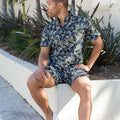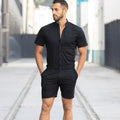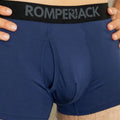Who would have thought that union suits would become one of 2025's most surprising fashion trends? These humble one-piece garments have come a long way from their Victorian beginnings as practical undergarments. The classic red flannel design with long arms and legs might seem simple, but there's a fascinating story behind these "emancipation union under flannel" pieces that were first patented back in 1868.
Here's something that might surprise you: union suits were originally designed for women, not men! These innovative garments appeared in the mid-1800s as a practical solution to the restrictive Victorian clothing that women had to endure. While similar designs existed before, the official 1868 patent marked the beginning of what would become a lasting design. The signature button-up front and rear flap has remained virtually unchanged for over a century and a half.
Ready to discover how these heritage pieces evolved from women's reform wear to winter essentials? We'll trace their journey through American fashion history and explore why men's union suits are suddenly popping up everywhere from high-end runway shows to social media feeds. You'll also learn about modern interpretations like the RomperJack union suit that's helping drive this resurgence while staying true to the garment's functional roots.
Whether you're curious about fashion history or considering adding a union suit to your wardrobe, this story of reinvention and timeless practicality might just change how you think about one-piece fashion!
The surprising origins of the union suit
The union suit's story reveals something fascinating that most people don't expect. This practical garment didn't start in men's closets at all—it began as a revolutionary piece for women during a time when fashion was literally suffocating them.
From women's reform wear to winter staples
Victorian women faced an incredible burden when getting dressed each morning. Can you imagine wearing up to 13 pieces of underwear at once? That's exactly what ladies dealt with, carrying around just in their undergarments. The corset sat at the center of this nightmare, squeezing women's waists down to an unnatural 20-22 inches—the standard size for corsets sold between 1860 and 1910.
These restrictive garments weren't just uncomfortable; they were genuinely dangerous. Women suffered from serious health issues like:
· "Chicken Breast" - extreme pressure that forced ribs to turn inward and overlap the sternum
· Lung compression that decreased oxygen flow to the blood
· Disrupted digestion and displaced organs
The reform movement recognized these problems and sought practical alternatives. Union suits emerged as more than just clothing—they represented freedom from physically harmful fashion choices. These 'emancipation garments' symbolized women's liberation from restrictive clothing that prioritized appearance over health.
The 1868 patent and what it meant
The breakthrough moment came in 1868. This revolutionary design combined a knit flannel shirt and drawers into one piece, completely eliminating the need for restrictive corsets.
Susan Taylor Converse took this concept even further in 1875 with her improved 'Emancipation Suit'. Her design featured a gathered section across the bodice that freed the breasts from compression, plus strategic button sets that helped suspend multiple skirt layers. Smart engineering that prioritized comfort without sacrificing function!
The press initially embraced these innovations. The Vermont Gazette reported in 1873 that demand was so high, local knitting mills had to run night shifts just to keep up with orders. Talk about a fashion revolution!
Why the name 'union suit' still sparks debate
Here's where things get interesting—historians still argue about where the name "union suit" actually comes from. Several theories exist, and honestly, each one makes sense:
The most obvious explanation points to the 'union' of top and bottom clothing into one piece. Another theory connects it to the Union Army, since Singer patented his sewing machine in 1851, and factories were producing both Civil War uniforms and union suits around the same time.
A third possibility suggests the name might come from an unknown older brand. The challenge with determining the true origin? People considered undergarments too taboo to discuss openly, so proper records weren't kept for over a century. Sometimes, the most practical innovations get overlooked in history books!
What we do know is that by the late 19th century, union suits had completely crossed gender lines. Men working in harsh conditions discovered that these garments were essential workwear that actually made their jobs more bearable. Function always finds a way to transcend fashion boundaries.
How union suits evolved through the decades
The 20th century brought incredible changes to the humble union suit. This one-piece wonder adapted to new technologies and shifting social norms while keeping its distinctive character intact. The journey from practical necessity to fashion statement shows just how adaptable great design can be.
The Munsingwear revolution
George D. Munsing changed everything when he arrived in Minnesota in 1886 to produce a new line of woolen union suits. His company, initially called Northwestern Knitting Company and later renamed Munsingwear, quickly became an underwear empire. The growth was remarkable - by 1900, they offered an impressive 80 styles of long underwear, and by 1917, the factory was producing a staggering 30,000 garments per day.
Munsingwear's marketing strategy proved especially bold for its time. They made advertising history in 1897 by featuring a young girl wearing a union suit in Ladies' Home Journal—the first time a company had shown underwear on a live model rather than displayed flat or illustrated. This daring approach paid off as sales boomed. By 1920, Munsingwear employed a workforce that was predominantly female, with women making up 85% of the workforce.
From itchy wool to silk-lined comfort
Traditional woolen underwear had one major problem—it was notoriously itchy and uncomfortable. Munsing tackled this persistent complaint head-on by developing an ingenious method for silk-plating wool, essentially knitting a layer of silk over wool fabric. The resulting garment maintained wool's excellent insulating properties while eliminating discomfort against the skin.
Fabric options continued to expand beyond the iconic red flannel as the decades passed. Here's what became available:
· 80% wool/20% nylon blends for easy care with wool's thermal qualities
· All-cotton union suits that didn't shrink in the laundry
· "Porosknit" mesh cotton material for breathability in warmer months
The shift from necessity to novelty
World War I brought practical modifications, notably the one-button flap seat replacing the traditional three-button drop seat. Central heating became more common in American homes, gradually reducing the urgent need for heavy thermal underwear.
Munsingwear adapted to these changing circumstances by establishing a design department in 1920 that emphasized their products as the latest fashion. They introduced new products like "Foundettes" girdles in the early 1930s, which proved crucial to the company's survival during the Great Depression.
The classic union suit eventually faced competition from two-piece alternatives like BVDs, which were summer-style, loose-fitting garments developed in the 1920s. Despite this competition, the original design has maintained its distinctive identity through changing times, with the button front and drop seat remaining its visual signatures.
Remember, great design endures because it solves real problems while adapting to new needs!
Why Union Suits Are Trending Again in 2025
Union suits have officially stepped out of the shadows and onto the fashion stage in 2025. Designers, influencers, and everyday consumers are all embracing these heritage pieces, and honestly, it's about time! This isn't just another fleeting trend—there are solid reasons why these one-piece wonders are capturing attention across different style communities.
The Rise of Functional Fashion
Fashion has gotten smarter, and people want clothes that actually work for their lives. Union suits nail this perfectly with their practical design that solves real comfort challenges. Unlike those historical garments you'd only see behind museum glass, union suits offer genuine comfort that speaks to today's lifestyle. The beauty lies in their simplicity—when something works this well, it naturally stays relevant through changing times.
Loungewear Meets Heritage Style
The pandemic changed how we think about comfortable clothing, and union suits found their perfect moment. Companies like DEN Loungewear are crafting modern versions from fabric with smart seam construction that keeps its shape wash after wash. Meanwhile, brands like Timoteo are getting creative with limited edition designs such as the Aspen Union Suit featuring:
· Plaid prints for visual interest
· Snap closures for easy wear
· Thoughtful details like chest and leg pockets
TikTok's Influence on Heritage Fashion
TikTok has become a game-changer for bringing traditional pieces back into the spotlight. The platform's mix of cooking, dancing, art, and fashion content has given heritage garments unexpected visibility. What's particularly powerful is TikTok's focus on authenticity—users love seeing real people show how union suits work as both practical garments and genuine style statements. This authentic approach resonates much more than traditional fashion marketing ever could.
Designer Revivals and Limited Drops
Billy Reid deserves credit for kickstarting the modern union suit revival back in 2008 when he discovered vintage red union suits in Alabama. Even with per batch, demand kept forcing additional manufacturing cycles. What's fascinating is that New York—not the South—became his strongest market, showing how this trend had broader cultural appeal.
Today, numerous retailers offer updated interpretations with technical improvements like UV-protective fabrics and moisture-wicking properties. These aren't just nostalgic recreations—they're genuinely improved versions of the original concept.
The Role of Nostalgia in Fashion
Union suits tap into something deeper than just practicality. They connect us to American ingenuity and no-nonsense functionality that feels increasingly valuable in our digital world. One retailer perfectly captured this sentiment, noting that union suits have "transcended their historical significance and have become a fashion trend, often worn as loungewear or even styled as outerwear".
This versatility, combined with authentic historical roots, creates the perfect storm for fashion revival. Remember, the best trends aren't just about looking good—they're about feeling connected to something meaningful while staying comfortable and practical.
Where to find the best modern union suits
Shopping for modern union suits opens up a surprisingly diverse marketplace. Traditional manufacturers and fashion-forward labels have both jumped on this trend, creating updated versions of this classic piece that blend heritage appeal with contemporary comfort.
Top brands offering stylish options
Several established brands currently dominate the union suit market. Carhartt produces durable options made from high-quality materials, and they're particularly popular with workers in cold climates. Patagonia offers thermal versions crafted from organic cotton or merino wool with excellent insulation and moisture-wicking properties. You'll also find quality options from Duluth Trading Company, L.L.Bean, and Woolrich.
For those seeking premium options, David Morgan sells heavyweight underwear knitted from an 80% wool and 20% nylon blend that provides absorbent comfort and warmth in a heavy rib knit. The investment is worth it if you prioritize quality and durability.
RomperJack union suit and other standouts
The modern designer revival kicked off when Billy Reid discovered vintage red union suits in Florence, Alabama. After purchasing the entire lot and incorporating them into his runway collection, demand forced multiple manufacturing cycles despite per batch. What's interesting is that New York—not the South—emerged as his strongest market.
DEN Loungewear specializes in signature union suits across various fabrics and fits, while Drake General Store produces modern onesies in 100% cotton with family-matching options. REI carries specialized variants, including NRS H2Core Lightweight options and Wild Rye women's designs.
What to look for in a quality men's union suit
A good union suit should help your body retain heat effectively. Look for waffle knits combined with brushed fabric for maximum warmth retention. Avoid options with rough seams—choose styles with flat, no-rub seams that prevent chafing. Fit matters tremendously here. You want a snug but roomy design that allows movement with proper sleeve and pant lengths.
Don't settle for something that feels restrictive. Remember, the whole point of a union suit is comfort and practicality!
Price ranges and material choices
Price points vary widely based on materials and construction. Basic cotton options from Big Feet Pajamas start around $48, while mid-range offerings from brands like Fruit of the Loom cost approximately $27. Premium options from Carhartt ($53) or wool-blend varieties from David Morgan ($140) represent higher-end investments.
Material innovations have transformed modern union suits beyond traditional red flannel. Options now include:
· Finely woven cotton nainsook for summer variants
· Vibrant prints and luxurious fabrics
· Technical improvements like UV-protective fabrics and moisture-wicking properties
Consider your budget and intended use when making your choice. A basic cotton option might be perfect for lounging, while premium wool blends excel in cold weather conditions.
Conclusion
The union suit's journey from Victorian reform wear to today's fashion statement shows just how timeless good design can be. What started as a practical solution for women's clothing restrictions has become a versatile garment that fashion-forward people across generations are embracing. After 150 years, these one-piece wonders have managed to adapt to changing needs while keeping their distinctive character intact.
The real magic of union suits isn't just their historical significance—it's their unmatched practicality. Unlike many heritage pieces that end up in museums, union suits actually solve genuine problems of comfort and convenience that matter just as much today. Their comeback in 2025 fashion makes perfect sense when you consider how they blend nostalgia with functionality—two things today's consumers really value.
Brands like RomperJack, Billy Reid, and DEN Loungewear have done something special by reimagining this classic garment. They've added modern touches while respecting its historical roots, helping introduce union suits to new audiences who appreciate both their comfort and unique style.
Having traced the complete journey of union suits from women's liberation garments to winter essentials and now to fashion statements, this comeback feels like more than just a passing trend. These garments represent something increasingly rare in our fast-fashion world—authentic design with a genuine purpose. Whether you wear them for warmth, comfort, or style, union suits offer a tangible connection to American practicality and innovation that still resonates today.
Remember, when you embrace this unexpected fashion revival, you're not just wearing a piece of clothing—you're participating in a living history that continues to evolve. The humble union suit has survived wars, technological revolutions, and countless fashion cycles because it fundamentally works. That staying power, coupled with its distinctive visual appeal, ensures this garment will remain relevant long after other trends have faded.
Don't be surprised if union suits become a permanent fixture in your wardrobe. After all, good design never really goes out of style—it just waits for the right moment to make its comeback!







